View in other NatureServe Network Field Guides
NatureServe
Montana
Utah
Wyoming
Idaho
Wisconsin
British Columbia
South Carolina
Yukon
California
New York
Silky prairie clover - Dalea villosa
Other Names:
Petalostemon villosus
State Rank Reason (see State Rank above)
In Montana, known from a few, small occurrences in the extreme eastern portion of the state. Current population levels and trends are unknown.
- Details on Status Ranking and Review
Population Size
Score3 - Vey Small: Generally <2,000 individuals.
Range Extent
Score1 - Peripheral, Disjunct or Sporadic Distribution in MT: Widespread species that is peripheral, disjunct or sporadically distributed within MT such that it occurs in <5% of the state (<7,500 sq. miles or the combined area of Beaverhead and Ravalli Counties) or is restricted to 4-5 sub-basins.
Area of Occupancy
Score2 - Low: Generally occurring in 4-10 Subwatersheds (6th Code HUC’s).
Environmental Specificity
Score2 - High: Species is restricted to a highly specialized and limited habitat and is typically dependent upon unaltered, high-quality habitat (C Values of 8-10).
Trends
Score0-3 - Population trends are unknown.
CommentUnknown.
Threats
Score1-2 - Medium to High.
CommentThreats are poorly documented though 3 sites occur along sandy roadsides, which could result in some adverse impacts. Conversely, there are no known threats that are high in magnitude.
Intrinsic Vulnerability
Score0-1 - Low to Moderate Vulnerability.
Raw Conservation Status Score
Score
9 to 14 total points scored out of a possible 19.
General Description
Silky Prairie Clover is a perennial herb with ascending or lax, branched stems that are 20-35 cm high sometimes resembling a shrub form, and which arise from red-orange roots and a rootcrown. The alternate, pinnately compound leaves are 2-4 cm long and have 11-21 linear leaflets. The foliage has numerous sunken glands and is densely long and hairy. The pink to rose-purple flowers are densely crowded in cylindrical spikes that are 3-12 cm long, at the ends of stems and branches. Each flower is 4-6 mm long and has 4 separate petals, a densely spreading, hairy, 5-lobed, cup-shaped calyx, and 5 stamens that are usually longer than the petals. The narrowly egg-shaped pods are 2-3 mm long and densely long and hairy.
Phenology
Flowering in late June-early August.
Diagnostic Characteristics
Other Dalea in Montana usually have <13 leaflets and are not as conspicuously hairy. The combination of the long, hairy calyx and 5 stamens further separate this species from other species of Dalea and from species of Psoralea and Amorpha.
Species Range
Montana Range
Range Descriptions
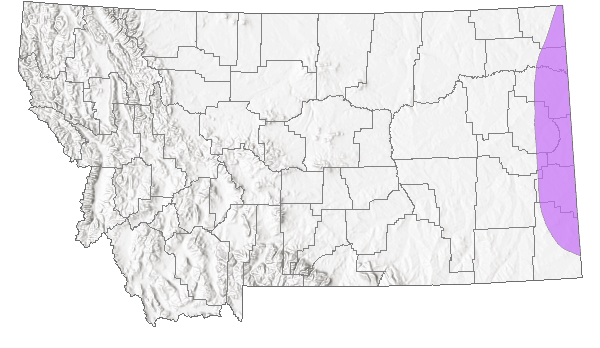
 Native
Native
Range Comments
Silky prairie clover is a Great Plains species known from Saskatchewan, Manitoba and Wisconsin south to New Mexico, Texas and Oklahoma.
Observations in Montana Natural Heritage Program Database
Number of Observations: 11
(Click on the following maps and charts to see full sized version)
Map Help and Descriptions
Relative Density
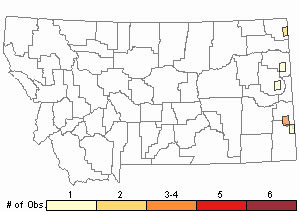
Recency
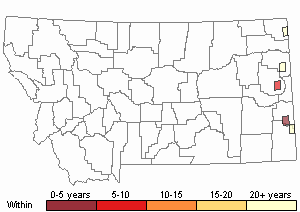
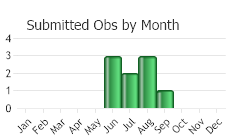
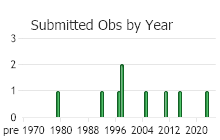
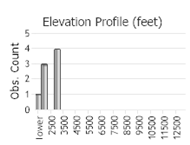 (Observations spanning multiple months or years are excluded from time charts)
(Observations spanning multiple months or years are excluded from time charts)
Habitat
Sandy soils of prairies and open woodlands often near sandstone outcrops or on dunes and roadsides. Sites are typically sparsely-vegetated. Common associated species include Calamovilfa longifolia, Andropogon hallii and Stipa comata.
National Vegetation Classification System Groups Associated with this Species
Grassland
Lowland - Prairie Grassland
Ecology
POLLINATORS The following animal species have been reported as pollinators of this plant species or its genus where their geographic ranges overlap:
Bombus auricomus,
Bombus pensylvanicus,
Bombus griseocollis, and
Bombus impatiens (Colla and Dumesh 2010, Williams et al. 2014).
Management
Maintain early successional, sandy habitats. Avoid direct impacts to populations and associated habitat. Avoid broadcast spraying of herbicides in the vicinity of populations; use care with spot spraying.
Stewardship Responsibility
Threats or Limiting Factors
STATE THREAT SCORE REASON
Threat impact not assigned because threats are not known (MTNHP Threat Assessment 2021).
References
- Literature Cited AboveLegend:
 View Online Publication
View Online Publication Colla, S.R. and S. Dumesh. 2010. The bumble bees of southern Ontario: notes on natural history and distribution. Journal of the Entomological Society of Ontario 141:39-68.
Colla, S.R. and S. Dumesh. 2010. The bumble bees of southern Ontario: notes on natural history and distribution. Journal of the Entomological Society of Ontario 141:39-68. MTNHP Threat Assessment. 2021. State Threat Score Assignment and Assessment of Reported Threats from 2006 to 2021 for State-listed Vascular Plants. Botany Program, Montana Natural Heritage Program, Helena, Montana.
MTNHP Threat Assessment. 2021. State Threat Score Assignment and Assessment of Reported Threats from 2006 to 2021 for State-listed Vascular Plants. Botany Program, Montana Natural Heritage Program, Helena, Montana. Williams, P., R. Thorp, L. Richardson, and S. Colla. 2014. Bumble Bees of North America. Princeton, NJ: Princeton University Press. 208 p.
Williams, P., R. Thorp, L. Richardson, and S. Colla. 2014. Bumble Bees of North America. Princeton, NJ: Princeton University Press. 208 p.
- Additional ReferencesLegend:
 View Online Publication
View Online Publication
Do you know of a citation we're missing? Anderson, N.L. 1951. Field studies on the biology of range grasshoppers of southeastern Montana. M.Sc. Thesis. Bozeman, Montana: Montana State University. 96 p.
Anderson, N.L. 1951. Field studies on the biology of range grasshoppers of southeastern Montana. M.Sc. Thesis. Bozeman, Montana: Montana State University. 96 p. Lesica, P., M.T. Lavin, and P.F. Stickney. 2012. Manual of Montana Vascular Plants. Fort Worth, TX: BRIT Press. viii + 771 p.
Lesica, P., M.T. Lavin, and P.F. Stickney. 2012. Manual of Montana Vascular Plants. Fort Worth, TX: BRIT Press. viii + 771 p. Lesica, P., M.T. Lavin, and P.F. Stickney. 2022. Manual of Montana Vascular Plants, Second Edition. Fort Worth, TX: BRIT Press. viii + 779 p.
Lesica, P., M.T. Lavin, and P.F. Stickney. 2022. Manual of Montana Vascular Plants, Second Edition. Fort Worth, TX: BRIT Press. viii + 779 p.
- Web Search Engines for Articles on "Silky prairie clover"





